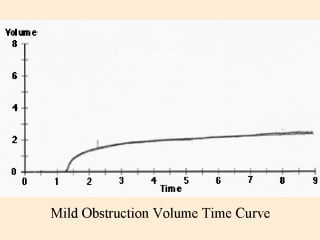 |
There
is a normal age-related decline in the FEV1/FVC ratio, so normal elderly patients without
airway obstruction will have a ratio below 70-80%. In this case, values below the
predicted FEV1/FVC ratio aid in diagnosing obstruction. The mid-range flows (FEF25-75) are
always reduced in obstructive airways disease. However, some patients have normal
spirometry with the exception of a reduced FEF25-75. While normal values for FEF25-75 have
broader ranges than the other spirometirc values, a mid-range flow less than 50% is likely
to be abnormal. This is suggestive of possible small airways dysfunction and potentially
early obstruction, but it should not be interpreted as meeting obstructive criteria. One
may consider a trial of bronchodilators, bronchoprovocative testing to exclude asthma, or
interpret this observation as a possible early indicator of smoking related lung disease. |
